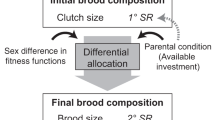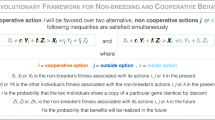Abstract
Older stronger siblings in many birds and mammals enjoy decisive and often lethal advantages in sibling competitions by virtue of being born or hatching first. Asynchronous hatching in birds divides the brood into core (advantaged) and marginal (disadvantaged) elements generating an asymmetric sibling rivalry with often fatal outcomes. Given that these asymmetries are under parental control, the obvious question is why parents seem to incite family conflict. Here I show in a model system (an altricial songbird) that family strife in the form of fatal sibling rivalry arises as a consequence of parental investor’s appetite for risk: in accord with an axiom of investment theory, obtaining greater potential rewards required taking greater risks. I analyze the risk and reward of investment in different family structures using a tool borrowed from modern portfolio theory, and show that the most successful parents gambled with brood size, placing bets on incipient families that often proved too large. Failed bets triggered a fatal sibling rivalry for insufficient resources. Parents driven to maximize reproductive success incited family strife among their offspring.
Similar content being viewed by others
References
Alexander R. M. (1996) Optima for animals (2nd ed.). Princeton University Press, Princeton, NJ
Black F., Scholes M. (1973) The pricing of options and corporate liabilities. Journal of Political Economy 81: 637–654
Brealey R., Myers S. (2003) Principles of corporate finance. McGraw-Hill, New York
Cassill D. L. (2003) Skew selection: Nature favors a trickle-down distribution of resources in ants. Journal of Bioeconomics 5: 83–96
Cassill D. L. (2006) Why skew selection, a model of parental exploitation, should replace kin selection. Journal of Bioeconomics 8: 101–119
Cassill D. L., Watkins A. (2010) The emergence of cooperative hierarchies through natural selection processes. Journal of Bioeconomics 12: 29–42
Donaldson-Matasci M. C., Lachmann M., Bergstrom C. T. (2008) Phenotypic diversity as an adaptation to environmental uncertainty. Evolutionary Ecology Research 10: 493–515
Elton E. J., Gruber M. J., Brown S. J., Goetzmann W. (2007) Modern portfolio theory and investment analysis (7th ed.). Wiley, New York
Forbes S. (2005) A natural history of families. Princeton University Press, Princeton, NJ
Forbes S. (2009) Portfolio theory and how parent birds manage investment risk. Oikos 118: 161–169
Forbes S. (2010) Family structure and variation in reproductive success in blackbirds. Behavioural Ecology and Sociobiology 64: 475–483
Forbes S. (2011) Social rank governs the effective environment of siblings. Biology Letters 7: 346–348
Forbes S., Glassey B. (2000) Asymmetric sibling rivalry and nestling growth in red-winged blackbirds. Behavioural Ecology and Sociobiology 48: 413–417
Forbes S., Glassey B., Thornton S., Earle L. (2001) The secondary adjustment of clutch size in red-winged blackbirds (Agelaius phoeniceus). Behavioural Ecology and Sociobiology 50: 37–44
Forbes S., Wiebe M. (2010) Egg size and asymmetric sibling rivalry in red-winged blackbirds. Oecologia 163: 361–372
Forbes L.S., Mock D.W. (1996) Food information and avian brood reduction. Ecoscience 3: 45–53
Forbes L. S., Thornton S., Glassey B., Forbes M., Buckley N. J. (1997) Why parent birds play favourites. Nature 390: 351–352
Ghiselin M. T. (1974) The economy of nature and the evolution of sex. University of California Press, Berkeley, CA
Glassey B., Forbes S. (2002a) Begging and asymmetric nestling competition. In: Wright J., Leonard M. L. (eds) Evolution of nestling begging: Competition, cooperation and communication. Kluwer Academic, Dordrecht, pp 269–281
Glassey B., Forbes S. (2002b) Muting individual nestlings reduces parental foraging for the brood. Animal Behavior 63: 779–786
Godfray H. C. J., Parker G. A. (1991) Clutch size, fecundity and parent–offspring conflict. Philosophical Transactions of the Royal Society of London B 332: 67–79
Greene C. M., Hall J. E., Guilbault K. R., Quinn T. P. (2009) Improved viability of populations with diverse life-history portfolios. Biology Letters 6: 382–386
Groothuis T. G. G., Muller W., von Engelhardt N., Carere C., Eising C. (2005) Maternal hormones as a tool to adjust offspring phenotype in avian species. Neuroscience and Biobehavioral Reviews 29: 329–352
Hall M. E., Blount J., Forbes S., Royle N. J. (2010) Does oxidative stress mediate the trade-off between growth and self-maintenance in structured families?. Functional Ecology 24: 365–373
Hammerstein P., Selten R. (1994) Game theory and evolutionary biology. In: Auman R., Hart S. (eds) Handbook of game theory with economic applications. Elsevier Science, Amsterdam, pp 931–962
Hudson R., Trillmich F. (2008) Sibling competition and cooperation in mammals: Challenges, developments and prospects. Behavioural Ecology and Sociobiology 62: 299–307
Kahneman D., Tversky A. (1996) On the reality of cognitive illusions. Psychological Review 103: 582–591
Kitano, H. (2010). Violations of robustness tradeoffs. Molecular Systems Biology, 6, Article number 384. doi:10.1038/msb.2010.40.
Lack D. (1947) The significance of clutch size. Ibis 89: 302–352
Leonard J. L. (1999) Modern portfolio theory and the prudent hermaphrodite. Invertebrate Reproduction and Development 36: 129–135
Lintner J. (1965) The valuation of risk assets and the selection of risky investments in stock portfolios and capital budgets. Review of Economics and Statistics 47: 13–37
Magrath R. D. (1990) Hatching asynchrony in altricial birds. Biological Reviews 65: 587–622
Markowitz H. M. (1991a) Foundations of portfolio theory. Journal of Finance 46: 469–477
Markowitz H. M. (1991b) Portfolio selection: Efficient diversification of investments (2nd ed.). Blackwell, Malden, MA
Maynard Smith J. (1982) Evolution and the theory of games. Cambridge University Press, Cambridge
Maynard Smith J., Price G. R. (1973) The logic of animal conflict. Nature 246: 15–18
Mock D. W., Forbes L. S. (1995) The evolution of parental optimism. Trends in Ecology and Evolution 10: 130–134
Mock D. W., Parker G. A. (1997) The evolution of sibling rivalry. Oxford University Press, Oxford
Mossin J. (1966) Equilibrium in a capital asset market. Econometrica 34: 768–783
Murphy G. I. (1968) Pattern in life history and the environment. American Naturalist 102: 391–403
Parker G. A., Maynard Smith J. (1990) Optimality theory in evolutionary biology. Nature 348: 27–33
Parker G. A., Mock D. W. (1987) Parent–offspring conflict and clutch size. Evolutionary Ecology 1: 161–174
Parker G. A., Royle N. J., Hartley I. R. (2002) Intrafamilial conflict and parental investment: A synthesis. Philosophical Transactions of the Royal Society of London B 357: 295–307
Real L. A. (1980) Fitness, uncertainty, and the role of diversification in evolution and behavior. American Naturalist 115: 623–638
Rödel H. G., Bautista A., García-Torres E., Martínez-Gómez M., Hudson R. (2008) Why do heavy littermates grow better than lighter ones? A study in wild and domestic European rabbits. Physiology and Behavior 95: 441–448
Royle N. J., Surai P. F., Hartley I. R. (2001) Maternally derived androgens and antioxidants in bird eggs: Complementary but opposing effects?. Behavioral Ecology 12: 381–385
Saether B.-E. (1990) Age-specific variation in reproductive performance in birds. In: Power D. M. (eds) Current ornithology. Plenum Press, New York, pp 251–283
Saino N., Ferrari R. P., Martinelli R., Romano M., Rubolini D., Møller A. P. (2002) Early maternal effects mediated by immunity depend on sexual ornamentation of the male partner. Proceedings of the Royal Society London Series B 269: 1005–1009
Schindler D. E., Hilborn R., Chasco B., Boatright C. P., Quinn T. P., Rogers L. A., Webster M. S. (2010) Population diversity and the portfolio effect in an exploited species. Nature 465: 609–612
Schwagmeyer P. L., Mock D. W. (2008) Parental provisioning and offspring fitness: Size matters. Animal Behavior 75: 291–298
Sharpe W. F. (1964) Capital asset prices: A theory of market equilibrium under conditions of risk. Journal of Finance 19: 425–442
Slagsvold T., Sandvik J., Rofstad G., Lorentsen O., Husby M. (1984) On the adaptive value of intraclutch egg-size variation in birds. Auk 101: 685–697
Sockman K. W., Sharp P. J., Schwabl H. (2006) Orchestration of avian reproductive effort: An integration of the ultimate and proximate bases for flexibility in clutch size, incubation behaviour, and yolk androgen deposition. Biological Reviews 81: 629–666
Stephens D. W., Krebs J. R. (1986) Foraging theory. Princeton University Press, Princeton, NJ
Teather K. (1992) An experimental study of competition for food between male and female nestlings of the red-winged blackbird. Behavioural Ecology and Sociobiology 31: 81–88
Trillmich F., Wolf J. B. W. (2008) Parent–offspring and sibling conflict in Galápagos fur seals and sea lions. Behavioural Ecology and Sociobiology 62: 362–375
Trivers R. L. (1972) Parental investment and sexual selection. In: Campbell B. (eds) Sexual selection and the descent of man, 1871–1971. Aldine, Chicago, IL, pp 136–179
Tversky A., Kahneman D. (1974) Judgment under uncertainty: Heuristics and biases. Science 185: 1124–1131
Weatherhead P. J., Dufour L. W. (2000) Fledging success as an index of recruitment in red-winged blackbirds. Auk 117: 627–633
Author information
Authors and Affiliations
Corresponding author
Rights and permissions
About this article
Cite this article
Forbes, S. Parental preference for investment risk incites family strife. J Bioecon 14, 115–128 (2012). https://doi.org/10.1007/s10818-011-9122-0
Published:
Issue Date:
DOI: https://doi.org/10.1007/s10818-011-9122-0




